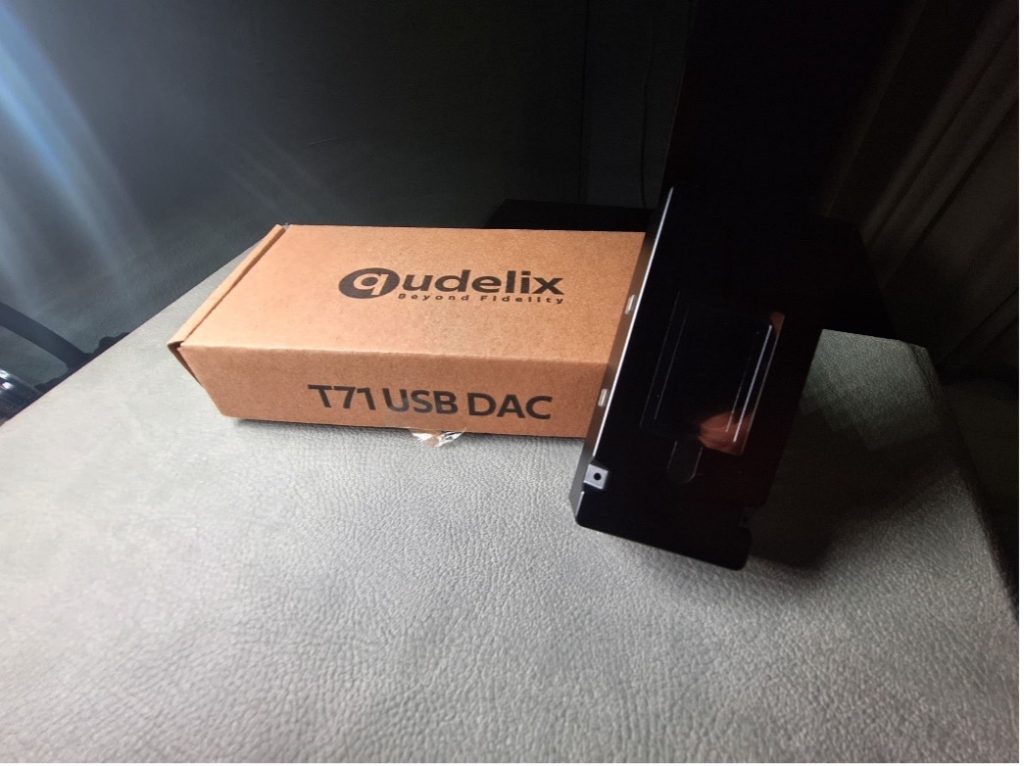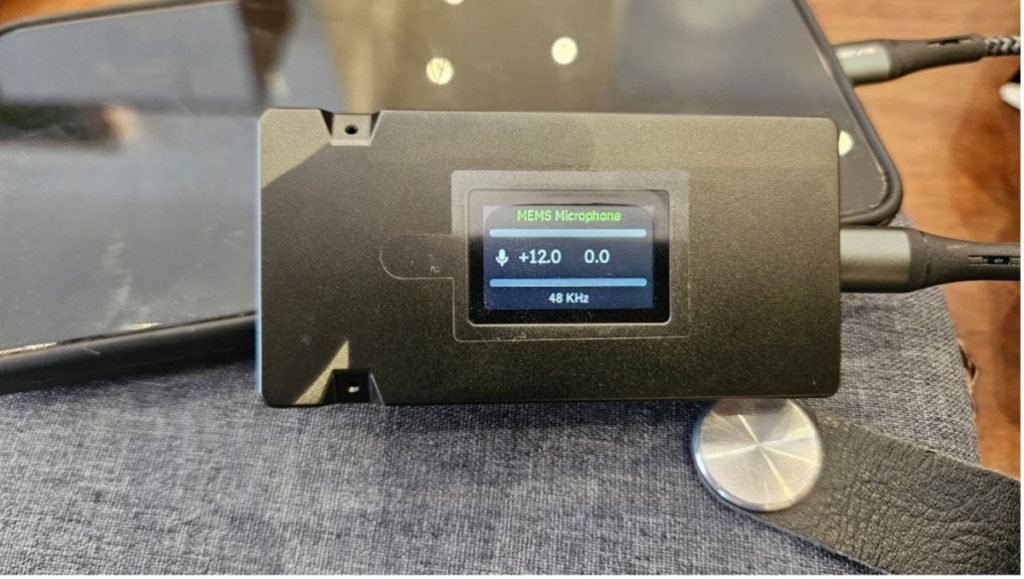
Introduction
Qudelix is a company originated from South Korea. They are renown for their Qudelix 5k, a small Bluetooth dongle that that has enhance software support, in particular their Equalization capability. To date, I don’t se any company that able to provide the same extensive software development for their audio hardware product as Qudelix 5.
In early 2024, Qudelix has launched a new product, Qudelik t71. The Qudelix T71 boast a additional 4.4 mm balanced jack, and 7.1 surround sound quality. Qudelix T71 loss 5K Bluetooth capability though. I understand the decision, the Qudelik 5K, while is an outstanding product, has weak staging, and blur direction, primarily due to Bluetooth connection. The wired connection able to provide better staging, and improve sense of direction.

Packaging and Software of Qudelik T71
The box has the traditional Qudelix packaging, with no manual at all. Simple and degradable packaging. Qudelix supplied one usb-A to usb c cable and one usb-c to usb-A cable, and two small elastic band. The T71 is significantly larger than 5k, perhaps 10 time bigger.

Software of Qudelik T71

The connection of software is either through Chrome widget, or Android Software. The control are similar with the Qudelik 5k. You are to control a number of features on the software, I don’t understand a lot of it, but you are able to control the microphone, and DSP, which I love a lot.
The microphone require a NSW setting on the Qudelix software. The microphone is unable to run on HighRes and Surround mode.


The sound of the microphone is similar to most earbuds mic quality. It does not reach the Quality level of dedicated microphone like the Boyo mic.
I am always astonished with the Qudelik software, especially their EQ support. User able to use the preset EQ, or locate their EQ profile from database of AUTO EQ. I believe this database is collected from Oratory 1990 database.


The purpose of this review to compare the EQ performance between Chord Mojo 2 and Qudelik T71. Chord Mojo 2 has 4 bands EQ, with acclaimed lossless EQ. The test is conducted using the EQ profile from Oratory1990. Since EQ profile for Qudelix is dcumentated by oratory1990 https://www.reddit.com/r/oratory1990/wiki/index/list_of_presets/, the EQ for Chord Mojo 2 is based on the emulation of the oratory’s graph. Both is using Harman Target Profile. The review is conducted using Etymotic Evo, and Senheiser H560s. The EQ Setup is as follows:
DSP Case Study with Qudelix t71
The digital signal processing (DSP) capabilities of the Qudelix t71 were tested using Sennheiser HD590s headphones . The following DSP settings were applied:
Oratory EQ Profile for HD560s



Mojo 2 Emulation to Oratory EQ For HD 560s


The digital signal processing (DSP) capabilities of the Qudelix t71 were tested using Etymotic Evo headphones . The following DSP settings were applied:
Oratory EQ EQ Profile for Etymotic Evo


Mojo 2 Emulation to Oratory EQ For Etymotic Evo


Ease of Use
The Qudelix t71 is celebrated for its straightforward plug-and-play functionality, ensuring a seamless setup process that even novice users can navigate with ease. This simplicity and user-friendliness make it an attractive option for users prioritizing convenience.In contrast, the Mojo 2 requires a more involved power-up sequence, which may be seen as a slight drawback for those seeking quick and hassle-free operation. However, the Mojo 2 gains versatility when paired with the Poly, an add-on that enhances its input and wireless playability. This pairing allows the Mojo 2 to support various wireless connections, making it a highly adaptable device for different listening environments and setups.
Sound Quality
Bass Tone:
- The Mojo 2 delivers a superior bass tone that is fuller and more textured, offering a rich, deep low-end that audiophiles will appreciate. In comparison, the Qudelix t71’s bass, while competent, lacks the same level of warmth and presence, making it slightly less impactful for bass-heavy genres.
Instrumental Timbre:
- When it comes to instrumental timbre, the Mojo 2 excels with a natural and detailed reproduction, especially notable in the depth of guitar plucks and other stringed instruments. This heightened realism and texture bring an added layer of immersion to the listening experience, which the Qudelix t71, although respectable, cannot quite match.
Treble:
- Treble performance varies significantly between the two devices. The Mojo 2 offers a warmer treble that, while pleasing, can feel somewhat constrained or claustrophobic compared to the Qudelix t71. The Qudelix t71 shines in this area with its superior treble separation, providing a crisp and airy high-frequency response. This separation enhances the clarity and distinction of high-pitched sounds, making the listening experience more detailed and spacious.
Soundstage:
- One of the standout features of the Qudelix t71 is its impressive soundstage. It offers a wide and expansive audio environment, allowing listeners to perceive the placement and movement of instruments more vividly. This attribute is particularly beneficial for genres that benefit from a broader spatial presentation, such as classical or live recordings. In contrast, the Mojo 2, while competent, does not deliver the same level of spatial depth and width, making the Qudelix t71 the preferred choice for those who value a more immersive soundstage.
Tested Songs
- “Shallow” by Lady Gaga: The Qudelix t71, while providing clear separation of treble, muted the treble and blurred the vocals, overshadowing Lady Gaga’s unique voice with instruments.
- “Why So Serious” from The Dark Knight soundtrack (3:44): The sub-bass performance of the Mojo 2 is particularly strong, delivering vibrations felt in the ears and air, enhancing the dramatic effect of the track.
- “Royals” by Lorde: The Mojo 2’s nuanced timbre brings out the musicality of slower songs, providing a rich and engaging experience.
- “Bad Guy” by Billie Eilish: The Qudelix t71 performs exceptionally well with this high-tempo song, delivering an impactful and energetic bass response.
Oratory EQ and Preset Performance
- Qudelix t71 Preset: The built-in preset of the Qudelix t71 is notably poor, with alterations often degrading the sound quality significantly. The bass is not well-boosted, the treble lacks proper extension, and overall, it merely pushes sounds forward without enhancing the listening experience.
- Oratory EQ: Applying the Oratory EQ to the Qudelix t71 software can significantly improve its performance. Oratory EQ provides data for precise EQ adjustments, effectively salvaging the Qudelix t71’s sound quality. This makes the device much more versatile than the Mojo 2, as the Oratory EQ adjustments enhance the overall sound without introducing degradation.
- Mojo 2: The Mojo 2 does not come with any preset EQ settings. However, its sound quality remains consistent and high-quality even with user-driven experimentation. Boosting the Mojo 2’s bass or making other adjustments generally does not degrade the sound quality unless taken to extreme levels. This flexibility allows users to tailor the sound to their preferences without compromising the inherent quality of the device.
Performance with Surround Sound and Dolby Atmos
- Music in surround sound sounds excellent with the Qudelix t71. This device delivers an accurate sense of direction for instruments, maintaining clear separation and an expansive soundstage. This is a significant bonus for Apple Music users, as the platform offers a substantial library of Dolby Atmos content. The Mojo 2, despite its many strengths, cannot match the Qudelix t71’s performance with 7.1 surround sound.
- Moreover, the Qudelix t71 excels with flat head earbuds, where sound direction is typically more limited. Its ability to enhance directional sound with these earbuds suggests it will also perform exceptionally well with movies and gaming, providing a versatile and immersive audio experience.
Conclusion
In summary, both the Qudelix t71 and Mojo 2 have distinct strengths that cater to different audiophile preferences:
- Qudelix t71: This device is ideal for users who prioritize ease of use, excellent treble separation, and a wide, immersive soundstage. Its impactful bass and ability to handle high-tempo tracks make it a great choice for contemporary music lovers who value a detailed and spacious listening experience. The application of Oratory EQ further enhances its versatility and sound quality. Additionally, its exceptional performance with 5.1, 7.1, and Dolby Atmos recordings makes it a standout choice for users who enjoy surround sound content. For Apple Music user, gamer, and movie enjoyer, qudelix t71 is a must for fully enjoy the Dolby Atmos atmosphere.
- Mojo 2: The Mojo 2 is best suited for listeners who seek superior bass tone, detailed instrumental timbre, and a warm, rich treble. Its nuanced performance on both fast and slow tracks highlights its capability to deliver a deeply musical and emotionally engaging experience, making it the preferred choice for audiophiles who prioritize sound quality and precision. The Mojo 2’s flexible sound adjustments without degradation, coupled with its versatility when paired with the Poly, add to its appeal. Mojo 2 however is not well suited for movies, or gaming as it geared towards music listening experience.
Each device brings unique qualities to the table, making the choice between them a matter of personal preference and listening priorities.
